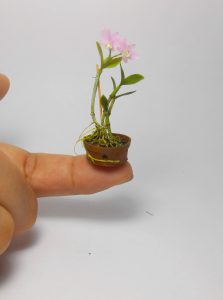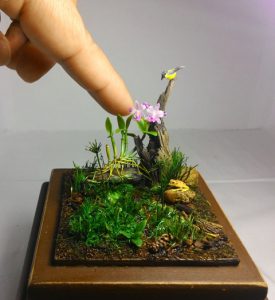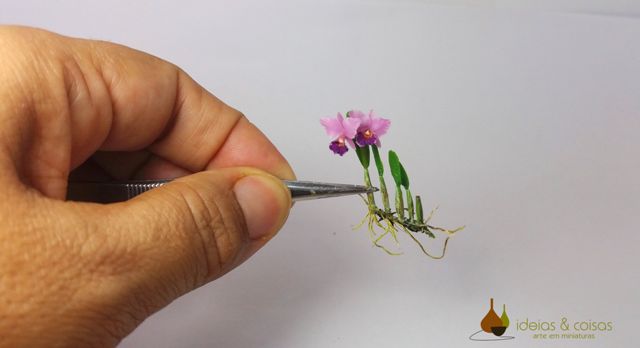Miniatures by Edi Oliveira Merez of Ideias & Coisas – arte em miniaturas
| Website | Facebook | Pinterest | YouTube |
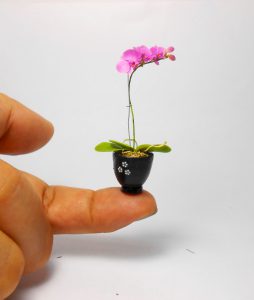 What was the first miniature you created?
What was the first miniature you created?
My first miniature was a kitchen setting made of paper.
How did you first get started making miniature orchids?
I started making miniature orchids when I accompanied my husband to an event of an orchid-related group that he attended. I made an orchid as a prize for a raffle they were organizing.
And what type of orchid was the miniature prize?
It was an Asian orchid, Vanda, which I made in 2011.
What is your favorite type of miniature orchid to make?
I like the Brazilian Cattleya Walkeriana.
What is the most challenging aspect of your work with miniatures in porcelain?
The most challenging aspect is to make the details of the lip in a flower.
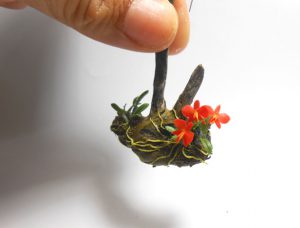 Tell us a bit about your passion for orchids. How does orchidophilia influence your work?
Tell us a bit about your passion for orchids. How does orchidophilia influence your work?
What enchants me about orchids is the variety of colors, shapes and perfumes, with more than 33 thousand species in the world.
Orchidophilia has full influence on my work, because I need to be constantly researching its forms, substrate, vase, observing every detail of the flowers, textures, bulbs, roots and leaves. From this meticulous observation, I make the miniature orchid, and it is not so simple.
Do you have many real orchids in your studio?
Yes, we cultivate lots of orchids next to my workshop and whenever I have any doubts about a particular form or color, I can visually examine an orchid to get a real example.
What is your favorite type of orchid?
I like the Brazilian hybrid “Cattleya Durigan,” the one with dots.
What advice would you give to new artists and beginner miniaturists?
- Analyze what you want to portray or replicate as a miniature. Look at it with no hurry. Take note of every subtle detail, then attempt to replicate it.
- Never, never be satisfied with the result, always push for perfection.
- Be humble, self-criticism is important! And lots of patience too.
- Always ask yourself if your work could be confused with reality.
Yes, lots of them.
Favorite miniature you own by another artist or have made yourself? *
I own a miniature from Sergio Macedo Netto, which I quite like.
What inspires you?
A love for nature and craftsmanship.
What is your hope for the field of miniatures?
As in other sectors of society, this industry should have means for inclusion. There are thousands of good artists in less developed countries, and by promoting such inclusion would increase market growth. How to do this? Through contests, awarding the best works (IGMA fills this role, but not quite all members are able to participate and study). The media in this segment in general (blogs, websites, magazines, etc.) could contribute a lot in the process, by granting exposure to lesser known artists.
To expand the industry, in my opinion, the artists in their own segments (food, clothing, flowers, etc.) should direct their work to consumers outside the collector sphere. For example, I have two audiences: miniaturists and orchid growers. For orchid growers, I make projects related to their universe on a larger scale, and it has opened a market whose clients include associations. I’ve received proposals worldwide from stores to sell my work.
Favorite miniature artisans?
Hiroyuki Kimura, Beth Freeman-Kane, and Sergio Macedo Netto.
Favorite flowers or plants you’d like to mention?
Yes, I really like Bonsai.
What would you like to see replicated in miniature that you have not yet seen?
A mountainous landscape.
The best part of making miniatures is to create and learn different ways of doing things.
What’s to come from ideias & coisas miniaturas?
I’m working on a project for a client: a greenhouse, which will have orchids, and some animals that I’ll make myself.
I intend to create a series of small scenes depicting orchids in their habitats.
I am also developing some realistic animals.
Words you live by?
I like a quote from Deepak Chopra: “Try the absurd and you’ll do the impossible.”
Other activities you enjoy?
I love furniture restoration and recycling.
What do you want miniature fans to know about you?
To make an orchid, I have to model by hand each separate part and then assemble the whole thing. In my work, each piece is unique, every model is made by hand, even the flowerpots. I use makeshift cutters that I make myself from soda cans, and for every new orchid, I make a new cutter. The time it takes to develop a piece is an average of six to eight hours.
I put a lot of love in my work and I believe that every person who gets a piece receives a portion of that love.
Ideias & Coisas – arte em miniaturas was created by Edi Oliveira Merez of São Paulo, Brazil. To see more of her miniatures, visit the ideias e coisas website, follow along on Facebook, check out Pinterest, or see what’s new on YouTube.

